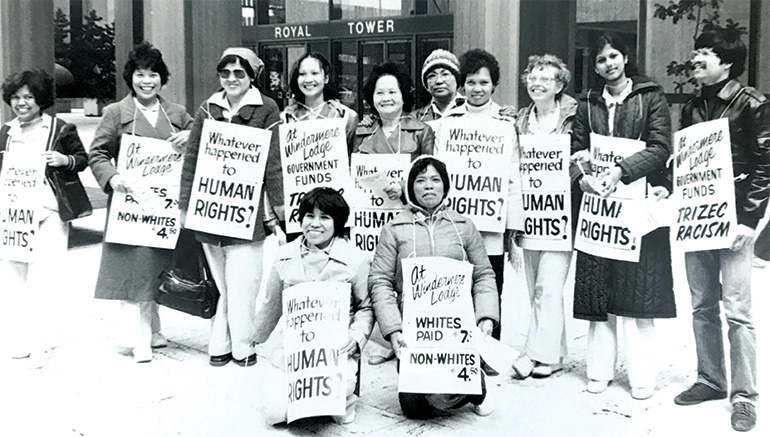
In 1974, HEU embarked on an ambitious organizing project to improve working and caring conditions in the private long-term care sector. At the centre of the union’s on-the-ground campaign was Sharon Yandle, who insists that success was earned only through the collective efforts of the workers themselves – including many who were initially terrified to join a union despite desperately needing one.
At the time, there were very few collective agreements in the sector, despite many attempts to organize.
What changed, and made successful organizing possible, was the establishment of the B.C. Labour Relations Board in 1972 – which simplified the process to join a union, especially for those working in essential services.
“At that time, we probably had the most favourable Labour Code for organizing,” says Yandle. “But you still had to sneak around. People were so, so very scared.”
The cloud of fear and intimidation looming over the long-term care sector did not lift easily. It took a very public campaign centred on the terrible conditions in residential care to embolden people to join a union.
Yandle went on call-in radio shows to publicize the poor conditions in residential care. Once word began to spread, Yandle and the two member organizers working with her – Mona Leaker from Lions Gate Hospital and Kathy Bakker from Children’s Hospital – were able to begin leafleting outside of facilities.
They discovered workers were motivated to join HEU not only for their own gain, but also because they wanted better, more humane care for seniors.
“When people called us, the motivating force for those workers were the conditions of patient care – that was number one,” says Yandle. “They were working in horrible conditions, and there is no shame in wanting to earn a good wage… but it was the conditions of patient care that moved people to action.”
At King George Hospital (which eventually closed), Yandle and the team put the organizing drive on hold to expose the deplorable conditions seniors lived in.
“We actually had to stop ourselves midway through organizing because the conditions were so bad,” says Yandle. “We started to collect affidavits from the staff about the conditions and made that very public.”
King George wasn’t the only site with problems.
At the Grandview Private Hospital (which is no longer in operation), supplies would be locked up overnight. The night shift would be forced to make due with whatever they could find. For incontinent residents, they used plastic bags and bread wrappers.
By exposing conditions like these, HEU was able to bring media and government attention to the issue, fight for workers and seniors at the sites, and enact change on a broader scale.
Yandle says having an NDP government was key to the union’s success.“They were very responsive, and I really believe accelerated the [eventual] introduction of the Long-term Care Program because of the things we were finding out.”
In 1978, government introduced the Long-term Care Program, which subsidized and standardized care in private, non-profit and government facilities.
It was a good start, but HEU still had to fight tooth and nail for every gain.
Seniors’ care workers were not only subject to heavy workloads in deplorable conditions, on average they earned minimum wage, were granted only the provincial vacation requirement of two weeks, and had no paid sick leave, even after many years of service.

Most of the workers were women, and a majority of them were people of colour. Yandle was shocked to learn that employers were using a two-tier, race-based wage system, which paid white workers more per hour even though they were doing the same jobs.
“Those workers also might have a different [job] title,” says Yandle. “It made no difference [to the work], whatsoever, except that it was completely racialized.”
During the hard-won Windermere strike of 1981, racialized pay and racism became explosive issues. The owner of the facility, Trizec, was publicly called out for its racist practice of paying higher wages to white workers, as most of the staff were new Canadians from the Philippines, Fiji, China and Portugal.
Yandle says holding a four-month, 24-hour strike line was not easy, but it had the support and solidarity of other HEU members.
In fact, HEU locals gave over $44,000 to supplement daily strike pay, and they helped cover the picket line when weekly strike meetings were held.
“This show of solidarity helped maintain the strike,” says Yandle. “Workers were encouraged to stay out on strike because of the support.”
After four months on the line, the strike ended with significant gains, including doing away with race-based wage disparity, almost doubling wages, bringing in benefits for the first time, and increasing vacation beyond the provincial minimum.
In less than a decade, HEU had managed to organize the majority of workers in the private long-term care sector and held 77 certifications. And while new barriers and challenges would arise in the decades to come, seniors’ care had become a central focus to the union’s struggle for quality, public health care.
by Sara Rozell